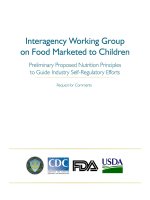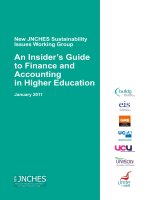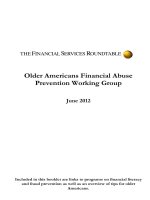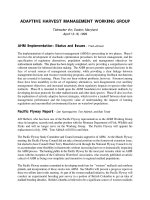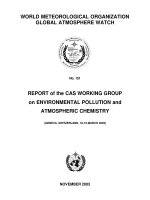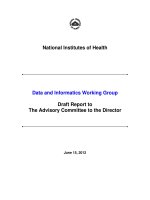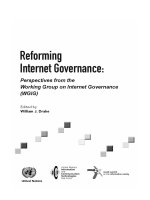final-slavery-working-group-overview
Bạn đang xem bản rút gọn của tài liệu. Xem và tải ngay bản đầy đủ của tài liệu tại đây (1.95 MB, 14 trang )
Influence of Slavery on American University
Initial Findings and Recommendations
A Report to Members of the Community from the
American University Working Group on the Influence of Slavery
Origins of the Working Group
February, 2018
• Concerns about links between slavery and AU were raised in an Eagle editorial that critiqued
the Founder’s Day Ball, an undergraduate dance that honors the life and work of AU’s
founder, the Rev. Bishop John Fletcher Hurst, in light of Hurst’s history as a slaveholder.
• It urged AU to “fund further research on the University’s involvement in slavery and slavebased wealth and publicly acknowledge its connection with slavery in the United States.”
April, 2018
Dr. Fanta Aw, Vice President of Campus Life and Inclusive Excellence, established the Working
Group on the Influence of Slavery and charged it with addressing three goals:
1) Review preliminary research conducted by the University Archivist and identify any gaps
to ensure completeness.
2) Suggest recommendations to Dr. Aw on how best to address the history and
communicate findings.
3) Engage campus community in constructive engagement around the issues.
Initial Questions for the Working Group
• Does AU have ties to slavery?
• If so, what are the nature of those ties?
• Were the financial resources of AU founder Bishop John Fletcher Hurst derived from a
slave economy, and if so, did it benefit AU?
• Did slaves fund the creation of AU?
MEMBERS OF THE WORKING GROUP
Rev. Mark Schaefer, University Chaplain
Bette J. Dickerson, Interim Assistant Vice President, Campus Life, Associate Professor
Emerita, Department of Sociology
Christine Platt, Managing Director, Antiracist Policy and Research Center
Sybil Roberts, Incoming Director, African-American and African Diaspora Studies Program
Leslie Nellis, Associate Archivist
Malgorzata J. Rymsza-Pawlowska, Director, Graduate Program in Public History, Assistant
Professor, Department of History
David Aldridge, alumnus (Class of 1987), American University
Nickolaus Mack, undergraduate student, American University
Historical Context
• AU was founded in 1893, after abolition but in a
former slaveholding region and by people with
potential personal ties to slavery
•
•
Two of DC’s major universities (Georgetown and George
Washington) were established before slavery’s 1862
abolition in the District.
•
Benefits from slavery for universities founded later would
be indirect, through wealth gained from slavery or other
channels.
•
Historical research can uncover the nature of those
benefits, reveal AU’s relationship to slavery, and inform
decisions about ways to acknowledge that history.
•
In the 1700s and 1800s,
enslaved people were
economically crucial to the area
and comprised a large part of
the population.
•
By 1820, the census shows that
31.2% of the District’s
population was black. Most
were enslaved.
•
By 1820, 26.4% of Maryland’s
population was enslaved and
another 9.8% was free nonwhite.
•
The black population in DC
throughout the 19th century
consistently ranged from 26%
to 33% and formed a mainstay
of the economy.
Three focal points to the investigation:
•
•
•
AU’s founder, John Fletcher Hurst. Did he have ties to
slavery, and if so, what were they?
AU’s property. What are its historic ties to slavery?
The Methodist Church. AU was founded as a Methodist
institution, with money raised nationwide. What was the
Methodist relationship to slavery?
John Fletcher Hurst’s Relation to Slavery
• In 1834, born in Maryland’s Eastern Shore to a family that
historically owned slaves to run their farms.
• In 1849, inherited one or two slaves. He was 15; his
known slave, Tom King, would have been around eight.
• In 1850, as a Dickinson College freshman, argued in favor
of abolition in a debate.
• In 1858, as a young Methodist minister, authorized Tom
King’s manumission in 1862, when King would turn 21.
• In 1859, records mixed feelings in diary about radical
abolitionism – admiring Henry Ward Beecher, but
unwilling to support “ultraism.”
Hurst and wife Catherine Lamont
Hurst; photo c. 1859
• In 1863, wrote in diary: “On my knees I declare that in
future I will be the black man’s friend, and if my previous
course has seemed dubious may God forgive me. The
riots in New York have disgusted me with conservatism.”
• In 1863, sold family farm.
The Methodist Church’s Relation to Slavery
• In 1784, the Methodist church gave two options to
slaveholding members: free slaves or leave the church.
• In 1785, that rule was suspended.
“We do hold in the deepest
abhorrence the practice of
Slavery, and shall not
cease to seek its
destruction, by all wise
and prudent means.”
- 1785, Methodist Church, in a caveat
to the decision to allow slaveholders
to keep their slaves
• In 1800, a rule stated that preachers with slaves must free
them “if practicable” or leave the ministry.
• In 1835, the Baltimore Conference of Methodist Episcopal
Church adopted a statement in favor of “peaceable, gradual
emancipation,” rejecting radical abolition.
• In 1836, bishops instructed clergy not to engage in abolition
work, a move resisted by many.
• In 1844, the church split over slavery after a plan to censure
a slaveholding bishop. Southerners broke away and formed
the Methodist Episcopal Church, South.
• In 1857, Hurst became a preacher in the East Baltimore
Conference; was appointed to a New Jersey church in early
1858, at age 23; and a month later promised to free his
slave Tom King, then around 17, when King turned 21.
The AU Property’s
Relation to Slavery
• In 1713, a plot of land was granted to Thomas Addison and James Stoddert. It became the
Friendship tobacco farm; AU’s property was its southern portion.
• In 1760, Murdock House (or “Friendship House”) was built where the AU President’s House now
stands. It was the area’s first substantive “country manor.” The farm had been inherited by the
Murdocks from Anthony Addison, who owned 20 slaves at his death.
• Nine people enslaved by the Murdocks were freed by the DC Emancipation Act in 1862, when
they are recorded as living in Georgetown. It’s unclear if they worked the land that is now AU, or
how many slaves lived on and worked the land from the mid-1700s to 1862.
• In the 1870s or 1880s, the Davis family bought the property. Members of the Davis family had
also owned slaves, including four people freed by the 1862 emancipation.
• In 1890, Hurst paid Achsah Davis $100,000 for the land for the proposed Methodist university.
How Did AU Benefit
from Slavery?
• Enslaved people were present
over the course of around 150
years on the land that became
American University.
• They also worked for families that
owned and lived on the land and
for the founder.
• AU relied on country-wide
fundraising to help purchase land,
build and develop the campus,
and open the University. These
funds no doubt included wealth
accumulated from and during the
slavery era in the United States.
8
Considerations:
Grappling with the Implications of Erasure and Complicity
What the Working Group could find is deeply impacted (and impoverished) by the vast gulf in voice
between those in the white power structure and those who were enslaved.
When Hurst and the Methodist Church wrestled with their own responses to an institution they opposed
in theory yet benefited from in practice, their ideas and experiences were recorded for the future. They
wrote and could preserve diaries, letters, records and more. That privilege wasn’t shared with enslaved
people.
Only one name of a Hurst slave is known so far: Tom King. But his story is not. Did he see freedom?
What did he, and others like him, experience afterwards? Other names of Hurst slaves may have
vanished in a fire that destroyed many Hurst family records, or may never have even been fully recorded.
Nor is there much information on people owned by other families in the AU story.
Were there slaves living and working on what is now AU land? Probably. But we don’t know who or
when. What was their story, during slavery and afterwards? We don’t know. That’s the nature of erasure.
Research will continue, but the overarching point is clear. While AU, founded in 1893 and nationally
funded, appears not to have benefitted directly from the sale of specific slaves, its founders benefited
financially from slavery and from complicity in the system, and the university’s history is entwined with
systemic injustice. Any way of acknowledging the enslaved people linked to the AU story will need to
grapple with the implications of erasure - both of people’s stories and of their rights.
Recommendations in Brief
Memorial
Markers and Spaces. Establish these, reflecting the recommendations.
Educational
Online Resource. Create a page on the University website dedicated to
sharing this information.
Knowledge Creation. Support scholarly efforts such as the Antiracist
Research and Policy Center and African-American and Diaspora Studies major.
Action
Anti-Racism Work. Knowledge of one’s past is essential to identifying a
course for the future. Find opportunities to intensify commitment to antiracism work
and advancing opportunities for DC residents.
Recommendation:
Acknowledgment through Memorialization
Several college campuses have
created or are in the process of
establishing memorials that address
their relationships to slavery.
Other ways that universities have
acknowledged their own institutional
relationships with slavery via
interventions in the physical
landscape (e.g. not including centers,
hires, and other initiatives) include:
• creating walking tours
• renaming buildings on campus
• holding memorial events .
Key Characteristics of Memorials:
• Encourage reflection
• Often reference archival
material such as names (if
known), dates, numbers
• In dialogue with physical
surroundings
• Are a beginning, not an end
Considerations for
Physical Acknowledgement / Memorialization
Absence and erasure
The American
University
Influence of Slavery
Working Group
has identified
a set of themes
to be kept in mind
as plans for
memorials and markers
move forward.
It is difficult to known fully the history and experiences
of slavery and enslaved people; these records are
absent.
The Working Group has
identified a set of themes
Multiplicity or to
decentralization
be kept in mind as
Slavery as institution
and enslaved
as
discussion
and people
research
individuals were present on the land where AU is now
located, at multiplecontinues.
spaces and points of time.
Contemplation
Continue to reflect upon remaining questions, and to
make connections between past and present.
Conversation
Pair with projects and programming from across AU
and partner institutions to call attention to AU’s own
story/ies, as well as the larger histories of slavery in
Washington and Maryland.
Recommendation:
Acknowledgment through Scholarship
and Community Action
Knowledge Creation. Support scholarly
efforts that address the African-American
experience, grapple with the implications of
erasure, and seek to understand systemic
injustices related to the history and impact
of slavery and racism. This could include
support for:
• Antiracist Research and Policy Center
• African-American and Diaspora Studies
major.
Knowledge Dissemination. Create a page
on the University website dedicated to
acknowledging and sharing information on
this aspect of the AU story.
Community Action:
• Acknowledge that a legacy of
benefiting from systemic injustices
includes a responsibility to give
back to the impacted community
• Deepen and redouble AU’s
commitment to work that
responds to this legacy,
particularly by advancing
opportunities for DC residents.
Implement Recommendations
AU Leadership, in partnership with
Influence of Slavery Working Group, will
determine recommendations to implement
in 2019
Next Steps:
2019
AU’s New Strategic Plan
Identify strategic goals in the new
AU Strategic Plan, such as “Partnership
with DC,” as ways to rededicate our
commitment to Washington DC and
advance educational opportunities for DC
Residents
Advance institutional work related to
AU’s Plan for Inclusive Excellence
